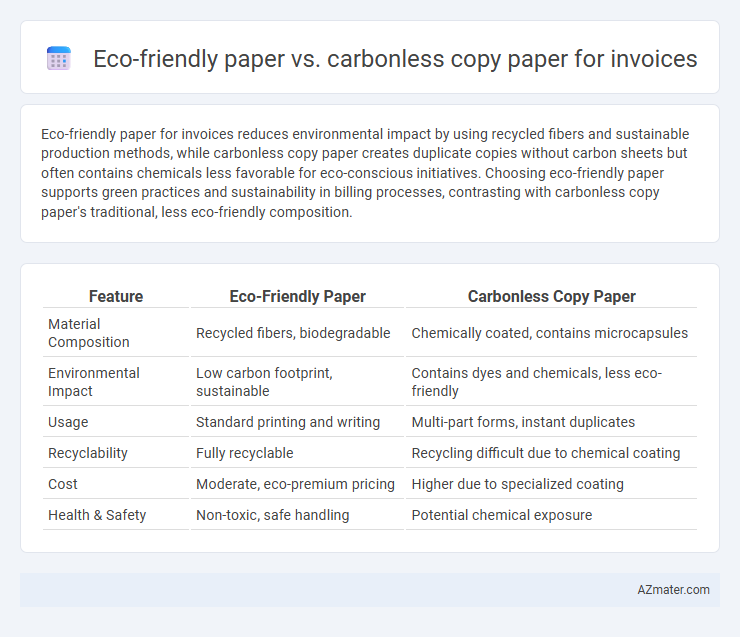Eco-friendly paper for invoices reduces environmental impact by using recycled fibers and sustainable production methods, while carbonless copy paper creates duplicate copies without carbon sheets but often contains chemicals less favorable for eco-conscious initiatives. Choosing eco-friendly paper supports green practices and sustainability in billing processes, contrasting with carbonless copy paper's traditional, less eco-friendly composition.
Table of Comparison
| Feature | Eco-Friendly Paper | Carbonless Copy Paper |
|---|---|---|
| Material Composition | Recycled fibers, biodegradable | Chemically coated, contains microcapsules |
| Environmental Impact | Low carbon footprint, sustainable | Contains dyes and chemicals, less eco-friendly |
| Usage | Standard printing and writing | Multi-part forms, instant duplicates |
| Recyclability | Fully recyclable | Recycling difficult due to chemical coating |
| Cost | Moderate, eco-premium pricing | Higher due to specialized coating |
| Health & Safety | Non-toxic, safe handling | Potential chemical exposure |
Introduction to Eco-Friendly Paper and Carbonless Copy Paper
Eco-friendly paper is made from sustainable sources, such as recycled materials or rapidly renewable fibers, and often uses non-toxic inks and minimal chemical treatments to reduce environmental impact. Carbonless copy paper, also known as NCR paper, contains micro-encapsulated dye or ink that transfers text onto subsequent sheets without the use of carbon paper, enabling multiple copies of invoices without messy originals. Choosing eco-friendly or carbonless copy paper for invoices depends on balancing sustainability goals with the need for efficient, duplicate documentation in business processes.
Understanding the Environmental Impact of Paper Choices
Eco-friendly paper for invoices typically uses recycled fibers and sustainable production methods, significantly reducing deforestation and greenhouse gas emissions compared to carbonless copy paper. Carbonless copy paper contains chemical coatings like BPA or BPS, which can pose environmental and health risks during manufacturing and disposal. Choosing eco-friendly paper minimizes environmental pollution and supports circular economy principles, making it a responsible option for sustainable business practices.
What is Eco-Friendly Paper? Key Features and Benefits
Eco-friendly paper is made from sustainable materials such as recycled fibers or responsibly sourced wood, minimizing environmental impact throughout its production process. Key features include reduced chemical use, lower energy consumption, and biodegradability, making it a sustainable alternative for businesses. Benefits of using eco-friendly paper for invoices include decreasing carbon footprint, supporting circular economy principles, and enhancing corporate social responsibility efforts.
How Carbonless Copy Paper Works: An Overview
Carbonless copy paper works by using micro-encapsulated dye or ink on the back of the top sheet and a reactive clay coating on the front of the bottom sheet, allowing pressure from writing or printing to create duplicate copies without carbon. This innovative mechanism ensures clean, efficient transfer of information, reducing the mess associated with traditional carbon paper. While eco-friendly paper emphasizes sustainability and reduced environmental impact, carbonless copy paper prioritizes functionality in producing instant, accurate invoice duplicates.
Sustainability Comparison: Eco-Friendly Paper vs Carbonless Copy Paper
Eco-friendly paper is typically made from recycled fibers or sustainable sources, significantly reducing environmental impact through lower water and energy consumption during production. Carbonless copy paper contains chemical coatings that can release harmful compounds and pose recycling challenges, making it less sustainable compared to eco-friendly alternatives. Choosing eco-friendly paper supports carbon footprint reduction and enhances waste management efficiency, aligning with green business practices.
Cost Analysis: Which Option is More Economical for Invoicing?
Eco-friendly paper typically involves higher initial costs due to sustainable sourcing and production processes, but it may reduce long-term expenses through improved recyclability and compliance with environmental regulations. Carbonless copy paper offers cost advantages by eliminating the need for separate carbon sheets, streamlining the copying process and lowering material costs in the short term. Businesses must weigh upfront expenditure on eco-friendly paper against ongoing savings and environmental impact to determine the most economical choice for invoicing.
Print Quality and Durability Differences
Eco-friendly paper typically offers consistent print quality with smooth texture and vibrant ink absorption, making invoices clear and professional-looking. Carbonless copy paper relies on a coated micro-encapsulated dye layer to transfer text without ink, which can sometimes result in less sharp images and potential fading over time. Durability varies as eco-friendly papers often use recycled fibers with enhanced longevity, while carbonless copy paper is more susceptible to smudging and degradation under environmental exposure.
Regulatory and Certification Considerations
Eco-friendly paper for invoices often complies with standards such as FSC (Forest Stewardship Council) and PEFC (Programme for the Endorsement of Forest Certification), ensuring sustainable sourcing and reduced environmental impact. Carbonless copy paper, commonly regulated under the TSCA (Toxic Substances Control Act) due to chemical coatings, must meet specific safety and environmental guidelines to avoid harmful substances like BPA or BPS. Businesses must verify certifications like FSC or Green Seal for eco-friendly paper and consult EPA regulations for carbonless paper to maintain compliance in invoicing practices.
Best Practices for Choosing Sustainable Invoice Paper
Selecting sustainable invoice paper involves prioritizing eco-friendly paper made from recycled fibers or certified by organizations like FSC, ensuring minimal environmental impact through responsible sourcing. Unlike carbonless copy paper, which often contains chemical coatings that can hinder recyclability and increase waste, eco-friendly paper supports a circular economy by enabling complete recycling and reducing harmful emissions. Businesses should evaluate paper composition, recyclability, and certification standards to align with best practices for reducing their carbon footprint while maintaining high print quality in invoicing.
Conclusion: Making the Greener Choice for Your Business
Choosing eco-friendly paper over carbonless copy paper significantly reduces your business's environmental footprint by minimizing harmful chemicals and promoting sustainable forestry practices. Eco-friendly invoices not only support waste reduction through recyclability but also enhance your company's green credentials, appealing to environmentally conscious clients. Investing in sustainable paper options aligns your business with global efforts toward resource conservation and corporate responsibility.

Infographic: Eco-friendly paper vs Carbonless copy paper for Invoice
 azmater.com
azmater.com